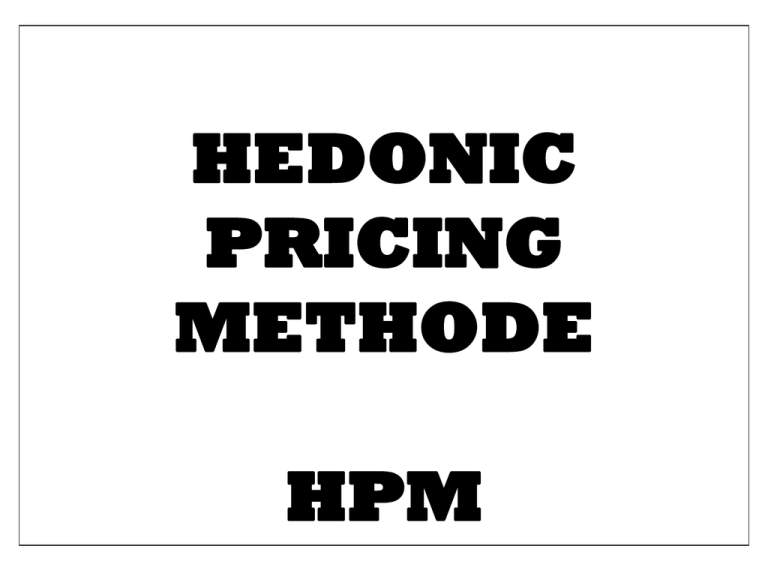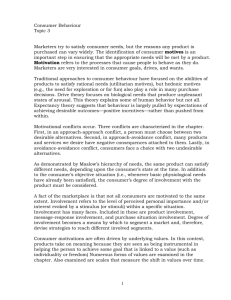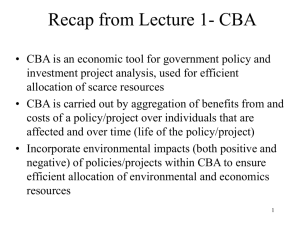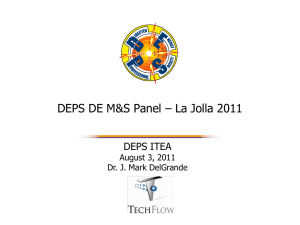HPM
advertisement

HEDONIC PRICING METHODE HPM VALUASI EKONOMI Trying to evaluate environmental values from an economic perspective was then ….. …… the equivalent of trying to value something priceless. He·don·ic 1. Of, relating to, or marked by pleasure (KESENANGAN). 2. Of or relating to hedonism or hedonists. He·don·ism 1. Pursuit of or devotion to pleasure, especially to the pleasures of the senses. 2. Philosophy : The ethical doctrine holding that only what is pleasant or has pleasant consequences is intrinsically good. 3. Psychology: The doctrine holding that behavior is motivated by the desire for pleasure and the avoidance of pain. DEFINISI HEDONIK Derived from the philosophy of hedonism (that happiness is the chief good in life), the notion that value is ultimately dependent on the satisfaction of wants and needs. The word hedonic is most often used together with the word price, as in hedonic price. This suggests the view that price is based on the satisfaction generated by consuming a good, regardless of the source of the satisfaction. This notion of hedonic is closely related to, and largely indistinguishable from, the more common concept of utility. Definition: Hedonic means of or relating to utility. (pleasure---- kesenangan --- kepuasan - utilitas) …….. Pemenuhan kebutuhan ……….. A hedonic econometric model is one where the independent variables are related to quality; e.g. the quality of a product that one might buy or the quality of a job one might take. PENDEKATAN HEDONIK The hedonic approach to economic assessment can be used for evaluating the economic value of environmental goods such as noise, air or water quality, landscape and similar ECOSYSTEM SERVICES AND goods. PENDEKATAN HEDONIK The hedonic approach is based on the assumption that goods and services can be considered aggregates of different attributes, some of which, as they cannot be sold separately, do not have an individual price. On real estate markets for example, it is not possible to purchase separately the room, the preferred location, the panoramic qualities, quality of air or of surrounding landscape. It is one frequently applied methodology for the assessment of natural values based on market values. PENDEKATAN HEDONIK The hedonic approach to evaluation attempts to estimate the economic value using implicit prices of single characteristics of a good on the basis of market values of the whole good. The use of this approach is of particular interest in the field of environmental valuation, as it can be assumed that the values attributed to natural resources are attributes of commodities which are sold on the market. Real estate properties are very interesting in this context, as their values are strongly influenced by locational characteristics. PENDEKATAN HEDONIK The approach assumes that the economic value of each attribute influences the total value of the commodity and can thus be revealed as a difference in price, for instance real estate properties, assuming all other characteristics to remain constant. It is based on the identification of the part of value which regards the characteristic to be evaluated, and in case of variations of the characteristic, on the possibility of estimating its demand function. TEORI HEDONIK The theory at the basis of hedonic methods have been formulated by Rosen (1974) and successively improved with regards to the valuation of environmental goods by Freeman (1979). Rosen’s model simulates a competitive market and foresees the simultaneous estimation of demand and supply function. In the particular case of real estate markets, with a very rigid supply, the model can be simplified and traced back to the neoclassic scheme of the theory of consumer’s demand (Diamond and Smith). ……… TEORI PERMINTAAN KONSUMEN …. ASUMSI-ASUMSI PENDEKATAN HEDONIK : 1. the market must offer a continuous range of choices, that means, all combinations between private good and environmental conditions; 2. purchasers must be able to behave according to the principle of decreasing marginal utility with respect to the environmental characteristics; 3. purchasers must have the same opportunity of access to the market. In other words, they must have the same cost of information, transaction and transfer, the same income available and the same mobility; 4. a perfect transparency of prices and characteristics must be given; 5. prices must adapt immediately to changes in the demand for environmental goods. Aplikasi pendekatan Hedonik berlangsung dua tahap: 1. estimate the value function of the private good; 2. estimate of the demand function of the environmental characteristics of the surplus. REGRESI HEDONIK The estimation of the function of the prices of private goods is generally obtained applying statistical methods of linear (or linearized) multiple regression: V = βo + βi Xi + Є In this way each single characteristic of the good is associated with a parameter ßi which represents the specification of the variable, the implicit price. KETERBATASAN PENDEKATAN HEDONIK : 1. it can be applied only in presence of a good number of market exchanges, as the model representing the market requires a certain number of good quality data; 2. the market must be sufficiently transparent; 3. the valuation might be biased if there are expectations with regards to changes in environmental qualities; 4. It is not possible to estimate the total economic value of the environmental good, but only the value connected to present and, with some caution, future uses. HPM: Hedonic Pricing Method The price is how much you pay for something . Pricing is when you decide how much it costs. The hedonic price Definition: The notion that the price of good is based on an assortment of characteristics that are both intrinsic to the good itself and external to the good. Hedonic pricing is commonly applied to the housing market in which the price of housing is based on the physical characteristics of the house (size, appearance, features) and the surrounding neighborhood (accessibility to schools and shopping, quality of other houses, availability of public services). Estimating hedonic prices makes it possible to identify the extent to which specific external factors affect the price. The prices of two houses may differ considerably, even with the same facilities (size, same structure, etc). The prices may reflect the difference of: Access to the work-place, commercial amenities, environmental facilities such as parks, Environmental qualities of the neighbourhood Such differences may imply that people are, to some extent, making a judgement on how much (more) they will spend for the quality of environment. For example, if a person were to choose between two identical houses, (a) one situated in clean environment, (b) the other in polluted area, which one would he/she buy or rent? What if the price of (a) is 5% higher than (b)? or 50% higher? The HPM technique uses property prices to assess: 1. How much of the property value differential reflects the difference in environmental values 2. How much people are willing to pay for an improvement of environmental quality and what the social value of the improvement is. HPM: Hedonic Pricing Model A statistical model used to identify factors or influences on the price of good based on the notion that price is based on both intrinsic characteristic and external factors. The hedonic pricing model is most commonly used in the housing market in which the price of housing is based on the physical characteristics of the house (size, appearance, features) and the surrounding neighborhood (accessibility to schools and shopping, quality of other houses, availability of public services). HPM: MODEL FAKTOR A model identifying price factors according to the premise that price is determined both by internal characteristics of the good being sold and external factors affecting it. HPM: Pasar Perumahan The most common example of the hedonic pricing method is in the housing market: The price of a property is determined by the characteristics of the house (size, appearance, features, condition) as well as the characteristics of the surrounding neighborhood (accessibility to schools and shopping, level of water and air pollution, value of other homes, etc.) The hedonic pricing model is used to estimate the extent to which each factor affects the price. HPM: Valuasi manfaat eksternal The hedonic pricing method infers the value of environmental features from the prices of traded goods. It is applicable in those cases where the prices of a good is directly influenced by environmental factors. The most frequently used example is the housing market, where the value of two otherwise comparable properties or apartments will differ depending on the environmental amenities in the vicinity of each site. Thus, if the proximity to a hazardous waste site leads to a measurable drop in the property price (compared to equivalent houses in other locations), this difference in prices gives an indication of the external cost of the waste site. Hedonic pricing can also be applied to the valuation of external benefits, e.g. if properties in the vicinity of an undisturbed river or lake command a higher price than comparable properties elsewhere. HPM: Methodology Hedonic property value models assert that individuals perceive housing units as bundles of attributes and derive different levels of utility from different combinations of these attributes. When transactions are made, individuals make tradeoffs between money and attributes that reveal that marginal values of these attributes. To estimate these marginal values, one gathers data about property values by using individual property sales in real estate markets. The price of a parcel or a house is then the dependent variable in a regression on the structural characteristics of the house, neighbourhood characteristics, and environmental quality. HPM: Methodology The coefficients on the attributes allow the analysts the recover the marginal values of those attributes. The hedonic housing price method has been used to place a value to environmental quality, climate change, and urban policies, such as traffic calming and pedestrian zone schemes. In theory, all of the effects of a policy—health effects, aesthetics, amenities, wildlife benefits, benefits of open space, etc.—should be subsumed into the changes in property values. Hedonic pricing methods are examples of revealed preference studies, because they rely on actual transactions. HPM: Prosesnya Hedonic property value models assert that individuals perceive housing units as bundles of attributes and derive different levels of utility from different combinations of these attributes. When transactions are made, individuals make tradeoffs between money and attributes that reveal that marginal values of these attributes. To estimate these marginal values, one gathers data about property values by using individual property sales in real estate markets. The price of a parcel or a house is then the dependent variable in a regression on the structural characteristics of the house, neighbourhood characteristics, and environmental quality. HPM: Process The coefficients on the attributes allow the analysts the recover the marginal values of those attributes. The hedonic housing price method has been used to place a value to environmental quality, climate change, and urban policies, such as traffic calming and pedestrian zone schemes. In theory, all of the effects of a policy—health effects, aesthetics, amenities, wildlife benefits, benefits of open space, etc.—should be subsumed into the changes in property values. Hedonic pricing methods are examples of revealed preference studies, because they rely on actual transactions. HPM: Strengths and weaknesses Strengths: 1. Allows one to examine multiple environmental and policy stressors 2. Based on market data Weaknesses: 1. Difficulties exist with correlation 2. Very sensitive to the choice of functional form 3. Very sensitive to the definition of the extent of the market 4. Suffer from econometric identification problems. HEDONIC PRICING MODEL A hedonic model of prices is one that decomposes the price of an item into separate components that determine the price. A simple, and common, example is that the price of a house may depend on its size, its location and other factors. It possible to construct a better model (especially when trying to construct a predictive model) by separating these factors. A hedonic model does not necessarily separate all the factors that could be separated, only those that affect the usefulness to a buyer of what is being sold. A good model should also separate out other factors: for example, a model of house prices should also separate out interest rates. HPM: Fungsi faktor Fungsi hedonic price, dapat dijelaskan mengenai faktorfaktor yang dapat mempengaruhi harga sebuah rumah (Ph) dapat dipengaruhi oleh: 1. Karakteristik lokasi (Si), contohnya adalah luas taman, ketersediaan garasi kendaraan, dan jumlah kamar. 2. Karakteristik lingkungan sekitar. (Nj), contohnya suku/etnis, tingkat kriminalitas, dan jumlah seolah di area tersebut. 3. Kualitas lingkungan (Qk), hal ini ditunjukan pada dengan kualitas udara dan tingkat kebisingan. HPM: Regresi Hedonik Fungsi hedonic price ini dapat dihitung dengan menggunakan ordinary least squares (OLS) atau persamaan regesi Ph = P (Si,Nj,Qk). Jika ditulis dalam bentuk matematis Ph = β0 + β1Si + β2Nj + βQk + ε β adalah intersep/koefisien, Si adalah karakteristik rumah itu sendiri, Nj adalah karakteristik lingkungan, Qk adalah kualitas lingkungan dan ε (eror) yang menunjukkan faktor lain yang turut menentukan harga rumah. Hedonic index In econometrics, a hedonic index is any price index which uses information from hedonic regression. Hedonic regression describes how product price could be explained by the product's characteristics. Hedonic price indexes have proved to be very useful when applied to calculate price indices for information and communication products (e.g. personal computers), because they can successfully mitigate problems such as those that arise from there being new goods to consider and from rapid changes of quality. REGRESI HEDONIK For example, for a linear econometric model, assume that at each period t we have nt goods, which could be described by a vector of k characteristics . Thus the hedonic (cross-sectional) regression is: where cit is a set of coefficients and ξit are independent and identically distributed, having a normal distribution N(0,σ2). INDEKS HARGA HEDONIK There are several ways the hedonic price indexes can be constructed. The two methods can be distinguished—direct and indirect. The direct method uses only information obtained from the hedonic regression, while the second method combines information derived from the hedonic regression and matched models (traditional price indexes). In indirect method, data used for estimating hedonic regression and calculating matched models indexes are different. Time dummy variable The Direct method could be divided into the Time Dummy Variable and Characteristic methods. The Time Dummy Variable is simpler, because it assumes implicit prices (coefficients of the hedonic regression - cit) to be constant over adjacent time periods. This assumption generally does not hold since implicit prices reflect both demand and supply. ……. Not constant INDEKS KUALITAS HEDONIK Hedonic quality index is similar to quantity index in traditional index theory—it measures how the price of obtaining set of characteristics had changed over time. For example, if we are willing to estimate the effect that characteristic growth (or decline) has had on the price of a computer for one period - from t to t+1, then the hedonic quality index would look like: where η , as in the case with price indexes, determines the type of the index. So, the chain quality index for the period from 0 to T would look like: and the base index: REGRESI HEDONIK A method used to determine the value of a good or service by breaking it down into its component parts. The value of each component is then determined separately through regression analysis. For example, the value of a home can be determined by separating the different aspects of the home - number of bedrooms, number of bathrooms, proximity to schools and using regression analysis to determine the value of each variable. REGRESI HEDONIK The word "hedonic" refers to pleasure, which economists link to the perceived value each part a good or service has to someone. This sort of regression analysis provides a good but not perfect - estimate of the value consumers place on a part of a whole. APLIKASI HPM While studying the application of the Hedonic Pricing Method, the first assumption made is the value of a house is affected by a particular combination of characteristics that it possesses given that properties with better qualities demand higher prices as compared to properties with lower qualities. FUNGSI HARGA HEDONIK The price of a house will thus be affected by the structural characteristics (s1, s2, s3...) of the house itself, characteristics of the locality/neighbourhood (n1, n2, n3...), and environmental characteristics (e1, e2, e3...) APLIKASI HPM Structural Characteristics could be anything from size of the house, to the number of rooms, type of flooring, etc. Neighbourhood attributes include variables like poshness of the locality, quality of roads, etc. And the environmental characteristics are variables such quality of air, proximity to parks, beaches, dumping yards, etc. Dua tahapan analisis: 1. The regression techniques to estimate the Hedonic Price Function 2. The regression to attain the marginal willingness to pay for the amenity. APLIKASI HPM The first stage involves employing regression techniques to estimate the Hedonic Price Function of the property. This function will relate the prices of many properties in the same housing area to the different characteristics. So Price Function (P) = f (s1, s2, s3...sj; n1, n2, n3,...nj; e1, e2, e3,...ej) This function could be linear or non-linear. The prices may change at an increasing or decreasing rate when the characteristics change. When you now differentiate the price function with respect to any one of the above characteristics, the implicit price function for that particular characteristic is yielded. It is considered implicit because the price function is indirectly revealed to us by what the people are willing to pay in order to obtain better quality or quantities of the characteristic. HPM: APLIKASINYA In the second stage, these implicit prices are regressed against the actual quantities/qualities chosen by the people in order to attain the marginal willingness to pay for the amenity. The results of this analysis will indicate the changes in property values for a unit change in each characteristic, given that all the other characteristics are constant. Some variables however may be correlated. This will result in similar changes in their values. HPM : KELEBIHANNYA The method can be comfortable adapted to take into consideration the several probable interactions between environmental quality and the marketed goods. This method is often used to approximate the values based the actual choices of the people. The real estate market is a good indication of the values as it is relatively efficient in responding to information. It is comparatively easier to obtain data on property sales and characteristics and can be easily compared to secondary data sources in order to acquire the descriptive variables for the regression analysis. HPM: Keterbatasan / Limitations 1. The scope of applying this model is restricted and limited to measuring the environmental benefits related to housing prices only. 2. The amount of data that needs to be collected and worked with is very large. 3. A prerequisite of the model is that everyone should have prior knowledge of the potential positive and negative externalities that are associated with purchasing the real estate property. For example, it is important that they know before-hand about the level of pollution in a locality situated near an industrial site. This however is not the case in reality. HPM: Keterbatasan / Limitations 4. The availability and accessibility of data directly affects the amount of time and the expense that will be undertaken to carry out an application of the model. 5. This method estimates people’s willingness to pay for the supposed variation in environmental qualities and their consequences. However, if the people are unaware of the relation between the environmental qualities and their benefits to them or the property, then the value will not be reflected in the price of the property. HPM Limitations 6. Market Limitations: This model makes an assumption that, given their income, people have the opportunity to choose the combination of attributes they prefer. What it fails to see is that the real estate market can also be affected by external factors such as interest rates, taxation, etc. For example : Suppose a family wishes to purchase a property near a popular city center, having a garden and of a large area. In reality - it may be possible that a house near the city center is comparatively smaller in size or does not have a garden. 7. Multicollinearity: Sometimes, there could be a case when Larger properties are only available in cleaner non-polluted areas and smaller properties are found in more urban and polluted environments. In such cases, it would be difficult to separate pollution and the size of property exactly. HPM: LIMITASI 8. Price Changes: Another assumption is that prices in the market will automatically adjust to any changes in the attributes. In reality, there is a lag especially in localities where purchase and sale of real estate is limited. 9. The model is relatively complex to interpret and requires a high level of statistical knowledge and expertise. Hedonic Pricing Method Overview The hedonic pricing method is used to estimate economic values for ecosystem or environmental services that directly affect market prices. It is most commonly applied to variations in housing prices that reflect the value of local environmental attributes. It can be used to estimate economic benefits or costs associated with: Environmental quality, including air pollution, water pollution, or noise Environmental amenities, such as aesthetic views or proximity to recreational sites HPM : OVERVIEW The basic premise of the hedonic pricing method is that the price of a marketed good is related to its characteristics, or the services it provides. For example, the price of a car reflects the characteristics of that car—transportation, comfort, style, luxury, fuel economy, etc. Therefore, we can value the individual characteristics of a car or other good by looking at how the price people are willing to pay for it changes when the characteristics change. The hedonic pricing method is most often used to value environmental amenities that affect the price of residential properties. HPM: Hypothetical Situation Agency staff want to measure the benefits of an open space preservation program in a region where open land is rapidly being developed. HPM: Why Use it? The hedonic pricing method was selected in this case because: Housing prices in the area appear to be related to proximity to open space. Data on real estate transactions and open space parcels are readily available, thus making this the least expensive and least complicated approach. HPM: Alternative Approaches If the open space of concern is used mainly for recreation, the travel cost method might be used. Alternatively, survey-based methods, like contingent valuation or contingent choice, might be used. However, these methods would generally be more difficult and expensive to apply. HPM: APLIKASINYA Step 1: The first step is to collect data on residential property sales in the region for a specific time period (usually one year). 1. 2. 3. 4. 5. The required data include: Selling prices and locations of residential properties Property characteristics that affect selling prices, such as lot size, number and size of rooms, and number of bathrooms Neighborhood characteristics that affect selling prices, such as property taxes, crime rates, and quality of schools Accessibility characteristics that affect prices, such as distances to work and shopping centers, and availability of public transportation Environmental characteristics that affect prices Residential Property In this case, the environmental characteristic of concern is the proximity to open space. The researcher might collect data on the amount and type of open space within a given radius of each property, and might also note whether a property is directly adjacent to open space. Often, this type of data may be obtained from computerbased GIS (geographical information systems) maps. Data on housing prices and characteristics are available from municipal offices, multiple listing services, and other sources. HPM: APLIKASINYA Step 2: Once the data are collected and compiled, the next step is to statistically estimate a function that relates property values to the property characteristics, including the distance to open space. The resulting function measures the portion of the property price that is attributable to each characteristic. Thus, the researcher can estimate the value of preserving open space by looking at how the value of the average home changes when the amount of open space nearby changes. HPM: How Do We Use the Results? The results can be used to evaluate agency investments in open space preservation. For example, specific parcels may be under consideration for protection. The hedonic value function can be used to determine the benefits of preserving each parcel, which can then be compared to the cost. HPM: RINGKASAN The hedonic pricing method is used to estimate the value of environmental amenities that affect prices of marketed goods. Most applications use residential housing prices to estimate the value of environmental amenities. The method is based on the assumption that people value the characteristics of a good, or the services it provides, rather than the good itself. Thus, prices will reflect the value of a set of characteristics, including environmental characteristics, that people consider important when purchasing the good. HPM: Valuasi ekonomi untuk: Environmental quality, Air pollution, Water pollution, or Noise Environmental amenities, such as aesthetic views or proximity to recreational sites The hedonic pricing method is relatively straightforward and uncontroversial to apply, because it is based on actual market prices and fairly easily measured data. If data are readily available, it can be relatively inexpensive to apply. If data must be gathered and compiled, the cost of an application can increase substantially. HPM: Harga Perumahan In general, the price of a house is related to the characteristics of the house and property itself, the characteristics of the neighborhood and community, and environmental characteristics. Thus, if non-environmental factors are controlled for, then any remaining differences in price can be attributed to differences in environmental quality. For example, if all characteristics of houses and neighborhoods throughout an area were the same, except for the level of air pollution, then houses with better air quality would cost more. This higher price reflects the value of cleaner air to people who purchase houses in the area. HPM: kebutuhan data dan informasi To apply the hedonic pricing method, the following information must be collected: A measure or index of the environmental amenity of interest. Cross-section and/or time-series data on property values and property and household characteristics for a well-defined market area that includes homes with different levels of environmental quality, or different distances to an environmental amenity, such as open space or the coastline. HPM: REGRESI The data are analyzed using regression analysis , which relates the price of the property to its characteristics and the environmental characteristic(s) of interest. Thus, the effects of different characteristics on price can be estimated. The regression results indicate how much property values will change for a small change in each characteristic, holding all other characteristics constant. HPM: Analisis Data The analysis may be complicated by a number of factors. For example, the relationship between price and characteristics of the property may not be linear – prices may increase at an increasing or decreasing rate when characteristics change. In addition, many of the variables are likely to be correlated, so that their values change in similar ways. This can lead to understating the significance of some variables in the analysis. Thus, different functional forms and model specifications for the analysis must be considered. HPM: Keuntungan / Kelebihan / Manfaat The method’s main strength is that it can be used to estimate values based on actual choices. Property markets are relatively efficient in responding to information, so can be good indications of value. Property records are typically very reliable. Data on property sales and characteristics are readily available through many sources, and can be related to other secondary data sources to obtain descriptive variables for the analysis. The method is versatile, and can be adapted to consider several possible interactions between market goods and environmental quality. HPM: Issues and Limitations The scope of environmental benefits that can be measured is limited to things that are related to housing prices. The method will only capture people’s willingness to pay for perceived differences in environmental attributes, and their direct consequences. Thus, if people aren’t aware of the linkages between the environmental attribute and benefits to them or their property, the value will not be reflected in home prices. The method assumes that people have the opportunity to select the combination of features they prefer, given their income. However, the housing market may be affected by outside influences, like taxes, interest rates, or other factors. The method is relatively complex to implement and interpret, requiring a high degree of statistical expertise. FAKTOR-FAKTOR PENENTU HARGA RUMAH DI KOTA MALANG (Penerapan Metode Harga Hedonik) PEMODELAN HARGA LAHAN KOTA BANDUNG DENGAN METODE HEDONIC Penelitian ini menjelaskan keterkaitan antara lokasi, infrastruktur perkotaan, dan status kepemilikan lahan, terhadap harga lahan, dengan menggunakan Hedonic Price Model. Hedonic Price Model menggunakan analisis regresi dan teori statistik sebagai dasar untuk menginterpretasikan variasi dalam sampel harga lahan, dalam pengertian hubungan variasi harga lahan dengan karakteristik lahan. Model ini memberikan hasil estimasi yang cukup signifikan secara statistik. Metode Hedonik Scale Scoring: Uji Organoleptik Pengujian organoleptik menggunakan metode uji hedonic scale scoring, dengan jumlah panelis 20 orang panelis. Uji ini dilakukan untuk mengetahui tingkat kesukaan panelis terhadap produk olahan pangan tertentu. Dalam uji ini panelis dimintakan tanggapan pribadinya tentang kesukaan atau sebaliknya ketidaksukaan dengan mengisi formulir penilaian yang telah disediakan oleh peneliti. Disamping panelis mengemukakan tanggapan suka atau kebalikannya, mereka juga memberikan komentar terhadap produk. Dalam penganalisisan skala hedonik ditransformasi menjadi skala numeric dengan angka menurut tingkat kesukaan. DAMPAK PENERAPAN METODE SL-PTT ( SEKOLAH LAPANG PENGELOLAAN TANAMAN TERPADU ) TERHADAP PENINGKATAN PRODUKSI PADI DENGAN PENDEKATAN REGRESI HEDONIK Untuk mengetahui besarnya dampak metode SL-PTT digunakan Analisis statistik berupa metode regresi hedonik. Hasil analisis regresi hedonik didapatkan model yang menghubungkan antara beberapa komponen teknologi dengan produksi padi dimana model signifikan, dengan R2 model 0.901, dan mean square error 0.045. Model hasil analisis tersebut mampu membuktikan bahwa dengan adanya metode SL-PT terjadi peningkatan produksi padi sebesar 19.7% PEMBUATAN DODOL TAPE PISANG Christina Timur Andriyani, 2005 Teknologi Jasa Dan Produksi, Fakultas teknik, Universitas Negeri Semarang. Tujuan dari percobaan pembuatan dodol tape pisang adalah untuk mengetahui tingkat kesukaan masyarakat terhadap dodol tape pisang, serta untuk mengetahui prospek usaha dodol tape pisang ditinjau dari harga jualnya. Untuk mengatahui tingkat kesukaan masyarakat terhadap dodol tape pisang adalah dengan uji organoleptik. Uji organoleptik dilakukan dengan uji hedonik panelis tidak terlatih sebanyak 80 orang. (kesukaan) oleh Hasil penilaian dodol tape pisang oleh 80 orang panelis menunjukkan bahwa aspek warna dodol tape pisang banyak disukai masyarakat dengan prosentase 76,25%, aspek rasa dodol tape pisang banyak disukai masyarakat dengan prosentase 76,56%, aspek aroma dodol tape pisang banyak disukai masyarakat dengan prosentase 75,93%, dan aspek tekstur cukup disukai masyarakat dengan prosentase 65,63%. Hasil analisis data proses produksi menunjukkan bahwa total biaya produksi adalah Rp 10.644.606,00. Harga jual dodol tape pisang dihitung berdasarkan perolehan laba 10% dari biaya variabel yang dikeluarkan dalam satu kali produksi sebanyak 42,5 kg. Harga jual dodol tape pisang per kg adalah Rp 8.400,00 sedangkan harga jual dodo, tape pisang per 500 g adalah Rp 4.200,00. pencapaian BEP setelah memproduksi sebanyak 13.963 kg, yang dapat dicapai setelah melakukan Pengaruh Motif Berbelanja Konsumen terhadap Pengambilan Keputusan Pembelian pada Hypermart MATOS (Studi pada Mahasiswa Fakultas Ekonomi Universitas Negeri Malang). Nur Hamidah, Sudarmiatin dan Lohana Juariyah, 2010. Program Studi Manajemen Pemasaran. Fakultas Ekonomi Universitas Negeri Malang. Belanja merupakan kegiatan yang menyenangkan bagi sebagian orang dan juga merupakan salah satu kegiatan rekreasi pada masyarakat dewasa ini. Berbeda dengan beberapa tahun lalu, sekarang kegiatan belanja bukan hanya sebagai aktivitas rutin untuk memenuhi barang-barang kebutuhan, tetapi sering kali kegiatan belanja menjadi hiburan untuk menghilangkan kejenuhan dari aktivitas sehari-hari yang dilakukan. Tujuan dari penelitian ini adalah untuk mengetahui (I) Deskripsi motif berbelanja konsumen dan pengambilan keputusan pembelian di Hypermart Malang Town Square (2) Pengaruh signifikan motif berbelanja (utilitarian shopping motives dan hedonic shopping motives) secara parsial terhadap pengambilan keputusan pembelian di Hypermart Malang Town Square. (3) Pengaruh signifikan motif berbelanja (utilitarian shopping motives dan hedonic shopping motives) secara simultan terhadap pengambilan keputusan pembelian di Hypermart Malang Town Square. Penelitian ini merupakan penelitian deskriptif korelasional. Pada penelitian ini, variabel bebas (X) yaitu motif berbelanja yang terdiri dari dua subvariabel yaitu utilitarian shopping motives) dan hedonic shopping motives. Sedangkan variabel terikatnya (Y) adalah pengambilan keputusan pembelian. Pengaruh Motif Berbelanja Konsumen terhadap Pengambilan Keputusan Pembelian pada Hypermart MATOS (Studi pada Mahasiswa Fakultas Ekonomi Universitas Negeri Malang). Nur Hamidah, Sudarmiatin dan Lohana Juariyah, 2010. Program Studi Manajemen Pemasaran. Fakultas Ekonomi Universitas Negeri Malang. Populasi dalam penelitian ini adalah Mahasiswa Fakultas Ekonomi Universitas Negeri Malang yang pernah berbelanja di Hypermart MATOS, yang jumlahnya tak terhingga. Untuk menentukan sampel digunakan rumus Daniel and Terrel, dengan tingkat kesalahan sebesar 0,05. Hasil penelitian menyimpulkan bahwa sebagian besar responden memiliki motif belanja utilitarian shopping motives dan hedonic shopping motives. Sebagian besar responden adalah mahasiswa Manajemen angkatan 2007 dengan jenis kelamin perempuan. Responden berbelanja minimal 1 kali dalam sebulan pada waktu sore dan malam hari. Meskipun keputusan pembelian konsumen dapat dipengaruhi oleh hedonic shopping motives, namun utilitarian shopping motives tetap memiliki pengaruh yang besar. Sebagian besar responden laki-laki memiliki motif belanja utilitarian shopping motives. Untuk menarik konsumen tipe hedonic shopping motives, perusahaan perlu menciptakan suasana belanja yang nyaman dan menyenangkan sehingga konsumen akan betah berlama-lama di Hypermart. Pemberian diskon, produk yang mengikuti tren dan mode terbaru juga dapat menarik konsumen tipe hedonic shopping motives. A Critical Review of Literature on the Hedonic Price Model and Its Application to the Housing Market in Penang The hedonic price model, derived mostly from Lancaster’s (1966) consumer theory and Rosen’s (1974) model, posits that a good possesses a myriad of attributes that combine to form bundles of utility-affecting attributes that the consumer values. Typically, a piece of property should command a higher price if it contains more of a desired attribute, or more desired attributes. We have sampled 120 condominium transactions in Penang to illustrate the applicability of the hedonic price model. The results show that all the coefficients are highly significant and of the expected sign. The empirical results also suggest that condominium units in Penang are very homogeneous, which is a very desirable characteristic for application of the hedonic price model. However, because preferred housing attributes may vary according to cultural and idiosyncratic factors, the attributes identified in previous studies, mostly in western countries, may not be sufficient in formulating the hedonic price models in Penang. There may be other attributes that are not significant in markets in western countries but significant in Penang. The hedonic price method in real estate and housing market research. A review of the literature. Herath, Shanaka and Maier, Gunther (2010) SRE - Discussion Papers, 2010/03. WU Vienna University of Economics and Business, Vienna. The Hedonic Price Method (HPM), also known as hedonic regression, is used for estimating the value of a commodity or the demand for a commodity. The HPM has been extensively used in real estate and housing market research in the recent past. In this paper, we discuss theoretical and methodological developments related to hedonic regression and undertake an examination of use of this methodology in the recent real estate and housing literature. We first define the HPM, and explain the fundamentals behind the methodology. The idea behind the HPM is that the commodities are characterized by their constitute properties, hence the value of a commodity can be calculated by adding up the estimated values of its separate properties. In the second part of the paper, we emphasise that the heterogeneous nature of real estate property justifies the use of HPM for estimating their value or demand. We also take a stock of most cited empirical studies on real estate and housing using the HPM, and classify those into several categories. The classification indicates that neighbourhood characteristics of real estate are relatively overresearched as a determinant of price or rent. It also shows that implicit value of structural characteristics is under-researched. In general, implicit value of environmental amenities in the neighbourhood and air pollution are relatively overresearched. The effect of social factors, i.e. racial segregation and crimes on real estate value is under-researched. ESTIMATION OF A HEDONIC PRICING MODEL FOR MEDIGAP INSURANCE John Robst Health Serv Res. 2006 December; 41(6): 2097–2113. This paper uses a unique database to examine premiums paid by beneficiaries for Medigap supplemental coverage. Average premiums charged by insurers are reported, as well as premiums by enrollee age and gender, and additional policy characteristics. Marginal prices for Medigap benefits are estimated using hedonic price regressions. In addition, the paper considers how additional policy characteristics and geographic differences in the use and cost of medical care affect premiums. Hedonic pricing equations are used to estimate implicit prices for Medigap benefits. With the exceptions of the part B deductible and drug benefit, Medigap supplemental insurance is priced consistent with the actuarial value of benefits offered under the standardized plans. Premiums vary substantially based on rating method, whether the policy is guaranteed issue, Medigap Select, or explicitly for smokers. Premiums increase with enrollee age, but do not vary between men and women. The relationship between premiums and enrollee age varies across rating methods. Attained-age policies show the strongest relationship between age and premiums, while community-rated premiums, by definition, do not vary with age. Medigap supplemental insurance premiums are higher in states with poorer health, greater utilization, and greater managed care penetration. THE AMENITY VALUE OF ENGLISH NATURE: A HEDONIC PRICE APPROACH Steve Gibbons, Susana Mourato, Guilherme Resende Spatial Economics Research Centre, LSE in its series SERC Discussion Papers with number 0074, 2011. Using a hedonic property value price approach, we estimate the amenity value associated with proximity to habitats, designated areas, domestic gardens and other natural amenities in England. There is a long tradition of studies looking at the effect of a wide range of environmental amenities and disamenities on property prices. But, to our knowledge, this is the first nationwide study of the value of proximity to a large number of natural amenities in England. We analysed 1 million housing transactions over 1996-2008 and considered a large number of environmental characteristics. Results reveal that the effects of many of these environmental variables are highly statistically significant, and are quite large in economic magnitude. Gardens, green space and areas of water within the census ward all attract a considerable positive price premium. There is also a strong positive effect from freshwater and flood plain locations, broadleaved woodland, coniferous woodland and enclosed farmland. Increasing distance to natural amenities such as rivers, National parks and National Trust sites is unambiguously associated with a fall in house prices. Our preferred regression specifications control for unobserved labour market and other geographical factors using Travel to Work Area fixed effects, and the estimates are fairly insensitive to changes in specification and sample. This provides some reassurance that the hedonic price results provide a useful representation of the values attached to proximity to environmental amenities in England. Overall, we conclude that the house market in England reveals substantial amenity value attached to a number of habitats, designations, private gardens and local environmental amenities. HEDONIC PRICE EFFECTS OF PEDESTRIAN- AND TRANSIT-ORIENTED DEVELOPMENT Keith Bartholomew Department of City & Metropolitan Planning, University of Utah, Salt Lake City, UT, USA, bartholomew@arch.utah.edu Reid Ewing Department of City & Metropolitan Planning, University of Utah, Salt Lake City, UT, USA Recent consumer surveys and demographic analyses have indicated a growing market for pedestrian- and transit-designed development. Theoretically, this market shift should be reflected in the price people are willing to pay for those styles of development. This article traces the literature that uses hedonic price methods for testing this hypothesis, either by assessing pedestrian/transit-design development holistically or by evaluating its component parts. The literature confirms that the market shift is, indeed, being capitalized into real estate prices and demonstrates that the amenity-based elements of transit-designed development play an important positive role in urban land markets, independent of the accessibility benefits provided by transit.







